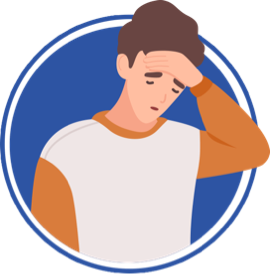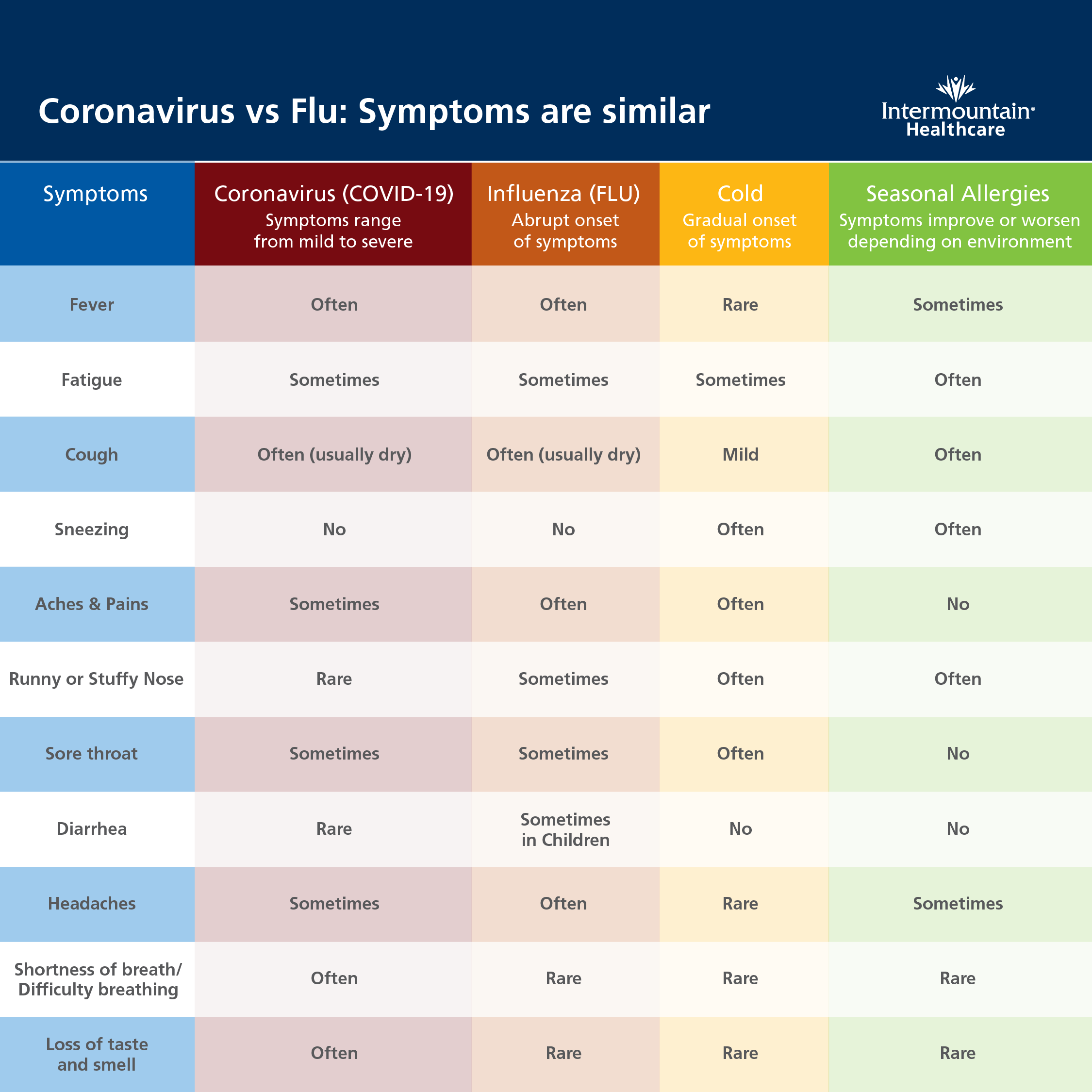
หน้าหลัก | สุขภาพดี | สุภาพสตรี | การแปลผลเลือด | โรคต่างๆ | ยารักษาโรค |วัคซีน | อาหารเพื่อสุขภาพ
If you have signs or symptoms of coronavirus disease 2019 (COVID-19), it's important that you contact your doctor or clinic right away for medical advice. But COVID-19, the common cold, seasonal allergies and the flu (influenza) cause many similar symptoms. So how can you tell if you have COVID-19? Understand the differences in symptoms that these illnesses cause, as well as how these illnesses spread, are treated and can be prevented.
What is COVID-19 (coronavirus), how does it spread, and how is it treated?
COVID-19 is a contagious respiratory disease caused by infection with the virus SARS-CoV-2. It usually spreads between people who are in close contact (within 6 feet, or 2 meters). The virus spreads through respiratory droplets released when someone breathes, coughs, sneezes, talks or sings. These droplets can land in the mouth or nose of someone nearby or be inhaled. The virus can also spread if a person touches a surface or object with the virus on it and then touches his or her mouth, nose or eyes, although this isn't considered to be a main way it spreads.
The most common symptoms of COVID-19 are a fever, cough and tiredness. But there are many other possible signs and symptoms.
Currently, only one antiviral drug, called remdesivir, is approved to treat COVID-19. Some drugs may help reduce the severity of COVID-19. The U.S. Food and Drug Administration has given emergency use authorization for three COVID-19 vaccines.
What’s the difference between COVID-19 and the common cold?
Both COVID-19 and the common cold are caused by viruses. COVID-19 is caused by SARS-CoV-2, while the common cold is most often caused by rhinoviruses. These viruses spread in similar ways and cause many of the same signs and symptoms. However, there are a few differences.
| Symptom or sign | COVID-19 | Cold |
|---|---|---|
| Cough | Usually (dry) | Usually |
| Muscle aches | Usually | Sometimes |
| Tiredness | Usually | Sometimes |
| Sneezing | Rarely | Sometimes |
| Sore throat | Usually | Usually |
| Runny or stuffy nose | Usually | Usually |
| Fever | Usually | Sometimes |
| Diarrhea | Sometimes | Never |
| Nausea or vomiting | Sometimes | Never |
| New loss of taste or smell | Usually (early — often without a runny or stuffy nose) | Sometimes (especially with a stuffy nose) |
While COVID-19 symptoms generally appear two to 14 days after exposure to SARS-CoV-2, symptoms of a common cold usually appear one to three days after exposure to a cold-causing virus.
There's no cure for the common cold. Treatment may include pain relievers and over-the-counter cold remedies, such as decongestants. Unlike COVID-19, a cold is usually harmless. Most people recover from a common cold in three to 10 days, although some colds may last as long as two or three weeks.
What’s the difference between COVID-19 and seasonal allergies?
Unlike COVID-19, seasonal allergies aren't caused by a virus. Seasonal allergies are immune system responses triggered by exposure to allergens, such as seasonal tree or grass pollens.
COVID-19 and seasonal allergies cause many of the same signs and symptoms. However, there are some differences.
| Symptom or sign | COVID-19 | Allergy |
|---|---|---|
| Cough | Usually (dry) | Sometimes |
| Fever | Usually | Never |
| Muscle aches | Usually | Never |
| Tiredness | Usually | Sometimes |
| Itchy nose, eyes, mouth or inner ear | Never | Usually |
| Sneezing | Rarely | Usually |
| Sore throat | Usually | Rarely |
| Runny or stuffy nose | Usually | Usually |
| Pink eye (conjunctivitis) | Sometimes | Sometimes |
| Nausea or vomiting | Sometimes | Never |
| Diarrhea | Sometimes | Never |
| New loss of taste or smell | Usually (early — often without a runny or stuffy nose) | Sometimes |
Also, while COVID-19 can cause shortness of breath or difficulty breathing, seasonal allergies don't usually cause these symptoms unless you have a respiratory condition such as asthma that can be triggered by pollen exposure.
Treatment of seasonal allergies may include over-the-counter or prescription antihistamines, nasal steroid sprays and decongestants, and avoidance of exposure to allergens where possible. Seasonal allergies may last several weeks.
What's the difference between COVID-19 and the flu?
COVID-19 and the flu are both contagious respiratory diseases caused by viruses. COVID-19 is caused by the SARS-CoV-2 virus, while the flu is caused by influenza A and B viruses. These viruses spread in similar ways.
COVID-19 and the flu cause similar symptoms. The diseases can also cause no symptoms or mild or severe symptoms. Because of the similarities, it can be hard to diagnose which condition you have based on symptoms alone. Testing may be done to see if you have COVID-19 or the flu. You can also have both diseases at the same time. However, there are some differences.
| Symptom or sign | COVID-19 | Flu |
|---|---|---|
| Cough | Usually (dry) | Usually |
| Muscle aches | Usually | Usually |
| Tiredness | Usually | Usually |
| Sore throat | Usually | Usually |
| Runny or stuffy nose | Usually | Usually |
| Fever | Usually | Usually — not always |
| Nausea or vomiting | Sometimes | Sometimes (more common in children) |
| Diarrhea | Sometimes | Sometimes (more common in children) |
| Shortness of breath or difficulty breathing | Usually | Usually |
| New loss of taste or smell | Usually (early — often without a runny or stuffy nose) | Rarely |
COVID-19 symptoms generally appear two to 14 days after exposure to SARS-CoV-2. Flu symptoms usually appear about one to four days after exposure to an influenza virus.
COVID-19 can cause more-serious illnesses in some people than the flu. Also, COVID-19 can cause different complications than the flu, such as blood clots and multisystem inflammatory syndrome in children.
While there is only one antiviral treatment for COVID-19, there are several antiviral drugs that can be used to treat the flu. Also, you can get an annual flu vaccine to help reduce your risk of the flu. The flu vaccine can also reduce the severity of the flu and the risk of serious complications. The vaccine can be given as a shot or as a nasal spray.
How can you avoid getting COVID-19, a cold and the flu?
When possible, get a COVID-19 vaccine. If you’re fully vaccinated, you can return to doing activities you might not have been able to do because of the pandemic, including not wearing a mask or social distancing in any setting — except where required by a rule or law.
If you haven’t had a COVID-19 vaccine, you can reduce your risk of infection from the viruses that cause COVID-19, colds and the flu by following several standard precautions. Research suggests that following these measures, such as social distancing and wearing a face mask, might have helped shorten the length of the flu season and lessened the number of people affected in the 2019-2020 flu season.
Standard precautions to reduce your risk of COVID-19, colds and the flu include:
Also, get an annual flu vaccine.
How can you prevent allergies?
The best way to prevent seasonal allergies is to avoid your known triggers. If you're allergic to pollen, stay inside with windows and doors closed when pollen is high.
Wearing a cloth face mask also might provide some protection against seasonal allergies. Masks can prevent you from inhaling some larger pollen particles. However, smaller pollen particles will still be able to get through a mask. It's also important to wash your mask after each use since a mask might carry pollen particles.
If you think you might have signs or symptoms of COVID-19, talk to your doctor. Remember, taking preventive measures can help you stay healthy.
Similarities and Differences between Flu and COVID-19
What is the difference between Influenza (Flu) and COVID-19?
Influenza (flu) and COVID-19 are both contagious respiratory illnesses, but they are caused by different viruses. COVID-19 is caused by infection with a coronavirus first identified in 2019, and flu is caused by infection with influenza viruses.
COVID-19 seems to spread more easily than flu. However, as more people become fully vaccinated against COVID-19, the spread of the virus that causes COVID-19 should slow down. More information about COVID-19 vaccines and how well they work.
Compared to flu, COVID-19 can cause more serious illnesses in some people. COVID-19 can also take longer before people show symptoms and people can be contagious for longer. More information about differences between flu and COVID-19 is available in the different sections below.
Because some of the symptoms of flu, COVID-19, and other respiratory illnesses are similar, the difference between them cannot be made based on symptoms alone. Testing is needed to tell what the illness is and to confirm a diagnosis. People can be infected with both flu and the virus that causes COVID-19 at the same time and have symptoms of both influenza and COVID-19.
While more is learned every day about COVID-19 and the virus that causes it, there are still things, such as post-COVID conditions, that are unknown. This page compares COVID-19 and flu, given the best available information to date.
How Long Symptoms Appear After Exposure and Infection
Similarities:
For both COVID-19 and flu, 1 or more days can pass between when a person becomes infected and when he or she starts to experience illness symptoms.
Differences:
If a person has COVID-19, it could take them longer to experience symptoms than if they had flu.
Flu
Typically, a person experiences symptoms anywhere from 1 to 4 days after infection.
COVID-19
Typically, a person experiences symptoms about 5 days after being infected, but symptoms can appear 2 to 14 days after infection.

How Long Someone Can Spread the Virus
Similarities:
For both COVID-19 and flu, it’s possible to spread the virus for at least 1 day before experiencing any symptoms.
Differences:
If a person has COVID-19, they could be contagious for a longer time than if they had flu.
Flu
Most people with flu are contagious for about 1 day before they show symptoms.
Older children and adults with flu appear to be most contagious during the initial 3-4 days of their illness but many people remain contagious for about 7 days.
Infants and people with weakened immune systems can be contagious for even longer.
COVID-19
How long someone can spread the virus that causes COVID-19 is still under investigation.
It’s possible for people to spread the virus for about 2 days before experiencing signs or symptoms (or possibly earlier) and remain contagious for at least 10 days after signs or symptoms first appeared. If someone is asymptomatic or their symptoms go away, it’s possible to remain contagious for at least 10 days after testing positive for COVID-19. People who are hospitalized with severe disease and people with weakened immune systems can be contagious for 20 days or longer.
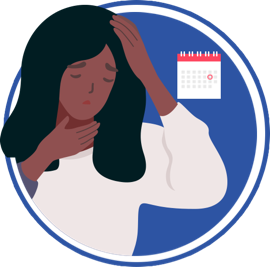
How it Spreads
Similarities:
Both COVID-19 and flu can spread from person-to-person between people who are in close contact with one another (within about 6 feet). Both are spread mainly by large and small particles containing virus that are expelled when people with the illness (COVID-19 or flu) cough, sneeze, or talk. These particles can land in the mouths or noses of people who are nearby and possibly be inhaled into the lungs. In some circumstances, such as indoor settings with poor ventilation, small particles might be spread further than 6 feet and cause infections.
Although most spread is by inhalation, it may be possible that a person can get infected by touching (for example, shaking hands with someone who has the virus on their hands) or by touching a surface or object that has virus on it, and then touching their own mouth, nose, or eyes.
Both flu viruses and the virus that causes COVID-19 can be spread to others by people before they begin showing symptoms; by people with very mild symptoms; and by people who never experience symptoms (asymptomatic people).
Differences:
While the virus that causes COVID-19 and flu viruses are thought to spread in similar ways, the virus that causes COVID-19 is generally more contagious than flu viruses. Also, COVID-19 has been observed to have more superspreading events than flu. This means the virus that causes COVID-19 can quickly and easily spread to a lot of people and result in continual spreading among people as time progresses.
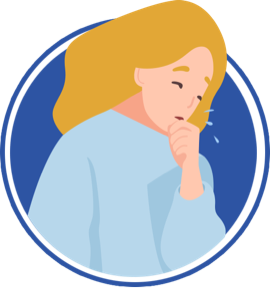
People at High-Risk for Severe Illness
Similarities:
Both COVID-19 and flu illness can result in severe illness and complications. Those at highest risk include:
Differences:
Overall, COVID-19 seems to cause more serious illnesses in some people.
For young children, especially children younger than 5 years old, the risk of serious complications is higher for flu compared with COVID-19. However, serious COVID-19 illness resulting in hospitalization and death can occur even in healthy young children.
Compared to young children, teens and adolescents with COVID-19 are more likely to have Multisystem Inflammatory Syndrome in Children (MIS-C), a rare but severe complication of COVID-19. However, for adolescents, the risk of serious COVID-19 illness is less than in children younger than 5.
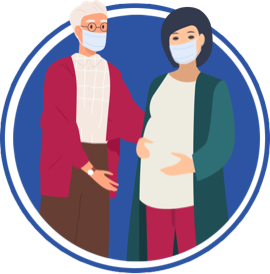
Complications
Similarities:
Both COVID-19 and flu can result in complications, including:
Differences:
Flu
Most people who get flu will recover on their own in a few days to two weeks, but some people will experience severe complications, requiring hospitalization. Some of these complications are listed above. Secondary bacterial infections are more common with influenza than with COVID-19.
Diarrhea is more common in young children with flu than in adults with flu.
COVID-19
Additional complications associated with COVID-19 can include:
Long COVID is a range of symptoms that can last weeks or months after first being infected with the virus that causes COVID-19 or can appear weeks after infection. Long COVID can happen to anyone who has had COVID-19, even if their illness was mild, or if they had no symptoms.

Approved Treatments
Similarities:
People at higher risk of complications or who have been hospitalized for COVID-19 or flu should receive supportive medical care to help relieve symptoms and complications.
Differences:
Flu
Prescription influenza antiviral drugs are FDA-approved to treat flu.
People who are hospitalized with flu or who are at increased risk of complications and have flu symptoms are recommended to be treated with antiviral drugs as soon as possible after illness onset.
COVID-19
The National Institutes of Health (NIH) has developed guidance on treatment of COVID-19external icon, which is regularly updated as new evidence on treatment options emerges.
The Food and Drug Administration (FDA) has approved one drug, remdesivir (Veklury®), to treat COVID-19. FDA has issued emergency use authorizationsexternal icon (EUAs) to allow healthcare providers to use investigational products that are not yet approved, or that are approved for other uses, to treat patients with COVID-19 if certain legal requirements are metexternal icon.
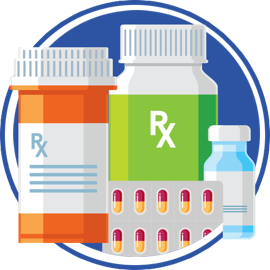
Vaccine
Similarities:
Vaccines for COVID-19 and flu are approved and/or authorized for emergency use (EUA) by FDA.
Differences:
Flu
There are multiple FDA-licensed influenza vaccines produced annually to protect against the 4 flu viruses that scientists expect will circulate each year.
COVID-19
Three COVID-19 vaccines have been authorized for use by FDA under an EUA. Other vaccines to prevent COVID-19 are under development.
What's the difference between a cold, the flu, seasonal allergies and coronavirus?
SHARE

If you prefer to listen to this article, click on the SoundCloud player below.
Fever, chills, body aches, and cough. All the symptoms seem the same for a cold, the flu, seasonal allergies, and coronavirus, also known as COVID-19. How do you know the difference? Here’s information to help you better understand the signs, symptoms, and treatments.
Cold
While you may feel miserable when you have a cold, the symptoms are generally mild compared to more aggressive viruses like the flu. A cold can cause any or all of these symptoms:
Most over-the-counter medications have, at best, moderate effects on cold symptoms. A typical cold will last on average 7 to 10 days. The majority of the symptoms are actually not caused by the infection itself, but rather our body’s immune system trying get rid of it. Most cold viruses will go away if we’re patient and give our bodies time to fight them. Your immune system is the greatest defense against the common cold.
More information about the common cold:
Flu
Seasonal influenza (flu) is still active and generally comes on fast and furious. It’s a common respiratory infection caused by a virus that affects your nose, throat, and lungs and can last from 5 to 7 days. Here’s are some common symptoms of the flu:
Unlike for colds or coronavirus, vaccination is a good way to prevent the flu. If you received a flu shot and still get the flu, your symptoms are generally milder than if you didn’t receive the flu shot. Most people with the flu get well without medical treatment. Stay home and get plenty of rest and fluids and treat a fever with acetaminophen (Tylenol) or ibuprofen (Advil, Motrin).
More information about the flu:
It’s important to remember that antibiotics won’t help any viral infections. Usually, the infections just need to run their course, so it’s best to just wait and watch. If your viral symptoms get better, and then days later suddenly get worse, you should contact your healthcare provider who can evaluate whether you may have a bacterial infection.
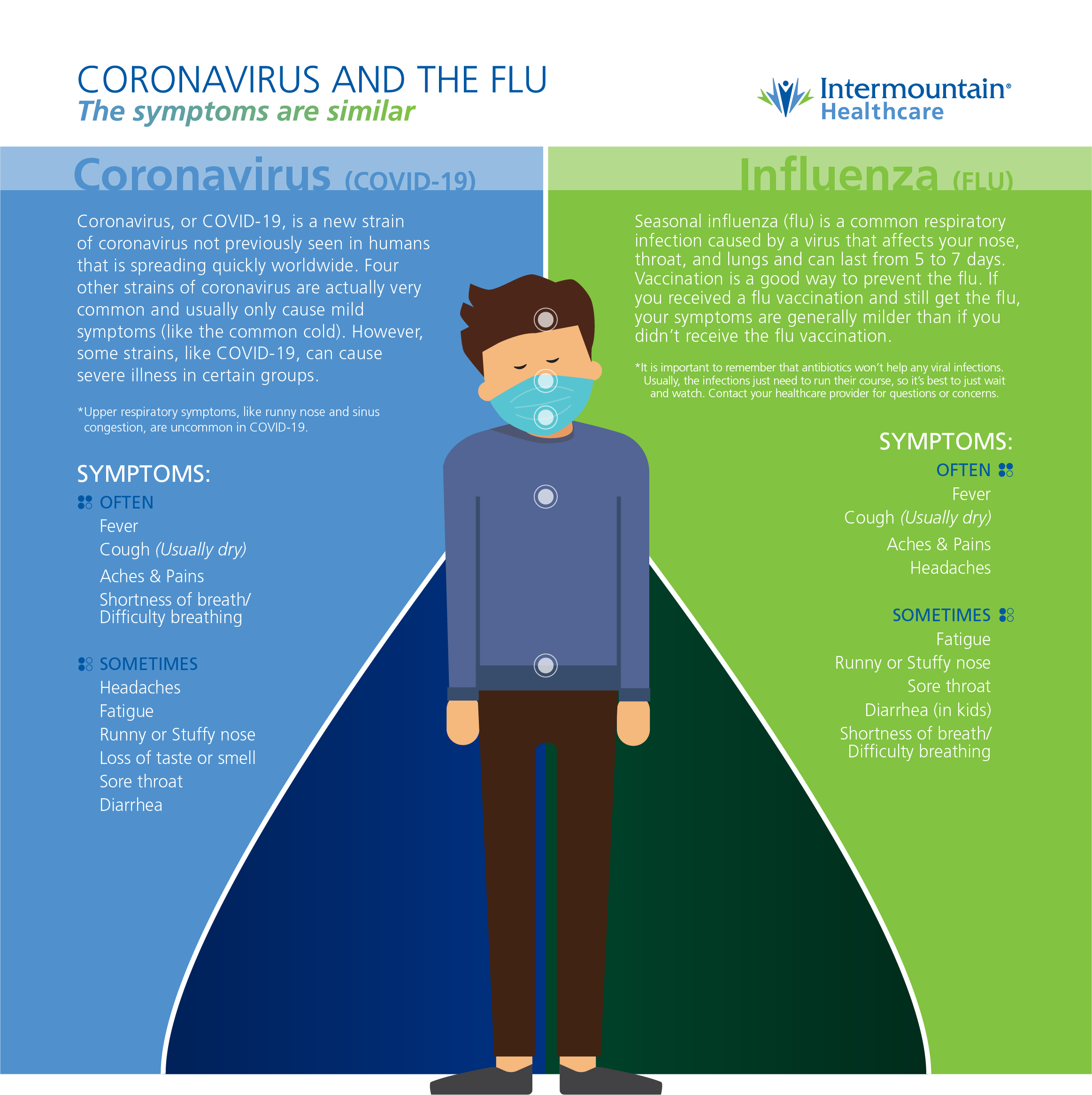
Seasonal Allergies
Spring is here and you’ve had a runny nose and itchy eyes since the snow started to melt. It’s possible that you might have a cold, but it could also be seasonal allergies. Here’s what to look for:
The most common cause of allergies in the spring is pollen. Pollen floats through the air from a variety of plants. Pollen is nearly invisible to the eye, but can wreak havoc on your body’s immune system. If you have springtime allergies, your body’s immune system is releasing antibodies to fight the allergens in your body. This will release histamines in your blood that trigger things like a runny nose or itchy eyes. You may experience more allergy symptoms on windy days when pollen counts are high.
Beyond basic prevention, there are also things you can do to help alleviate the symptoms of your springtime allergies. Over the counter medications such as antihistamines and decongestants can help reduce sneezing, itching, and congestion. You may also find relief with a nasal spray that can help decongest or ease inflammation in your sinuses. In addition, eye drops may also help relieve itchy or watery eyes.
https://www.mayoclinic.org/diseases-conditions/coronavirus/in-depth/covid-19-cold-flu-and-allergies-differences/art-20503981
https://www.cdc.gov/flu/symptoms/flu-vs-covid19.htm

